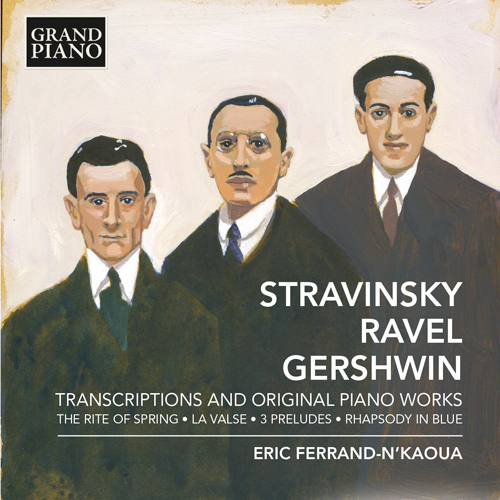Available only in the US.
STRAVINSKY, I. / RAVEL, M. / GERSHWIN, G.: Transcriptions and Original Piano Works (Ferrand-N'Kaoua)
Stravinsky’s groundbreaking Rite of Spring is heard on this recording in the formidable yet seldom performed solo piano transcription by the 20th-century American composer and pianist Sam Raphling. It is coupled with Ravel’s own virtuosic transcription of La Valse, Gershwin’s jazz-infused 3 Preludes and his own solo piano version of Rhapsody in Blue.
Tracklist
Raphling, Sam - Arranger
| 5 | Part I: Adoration of the Earth: Ritual of the Rival Tribes - Procession of the Sage - The Sage - | 02:52 |
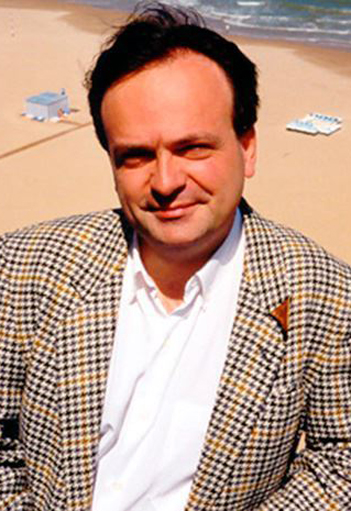
French pianist Eric Ferrand-N’Kaoua (pronounced Ennkawa) was born near Paris in 1963. He studied with Madeleine de Valmalète from an early age and soon entered the Conservatoire National Supérieur, where he obtained first prize with distinction in piano when aged only fourteen, soon followed by a first prize in chamber music.
Finalist and prizewinner of the Clara Haskil and the Santander Competitions, he started performing as a soloist with several Japanese orchestras before the age of 20.
He then started collaborations with musicians from Eastern Europe, such as the USSR State Symphony Orchestra and the Moscow Soloists, and performed several times in the former USSR. He is a regular guest of the Miami International Piano Festival and has performed at the Theâtre du Châtelet (Paris), the Wigmore Hall (London) and the Mariinsky Concert Hall (St Petersburg). He is also an avid chamber music performer and forms an unconventional duo with the French violinist Gilles Apap.
EFN’K has premièred works by Thierry Lancino, Philippe Racine and Christopher Culpo. His eclectic repertoire and his interest in jazz allow him to blend Bach’s Goldberg Variations, or Liszt’s transcription of Berlioz’s Symphonie fantastique with jazz-inspired pieces in the same recital. This recording is a personal tribute to music from Russia, France and America.
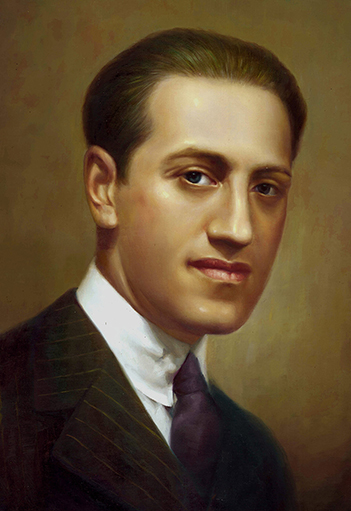
In a period in which American nationalist music was developing with composers of the calibre of Aaron Copland and others trained in Europe, George Gershwin, the son of Russian Jewish immigrant parents, went some way towards bridging the wide gap between Tin Pan Alley and serious music. He won success as a composer of light music, songs and musicals, but in a relatively small number of compositions he made forays into a new form of classical repertoire.
Stage Works
Gershwin won serious attention with his opera Porgy and Bess, a drama of Black America, set at first in Catfish Row, Charleston, South Carolina. There is an effective instrumental suite, Catfish Row, derived from the opera, while the attractive song ‘Summertime’ has proved particularly memorable.
Orchestral Music
Gershwin’s Rhapsody in Blue, written in 1924 for Paul Whiteman and his jazz band, marries jazz with something of the classical concerto form, an avenue further explored in Gershwin’s Piano Concerto of the following year. The tone poem An American in Paris again offers a synthesis between apparently divergent forms of music.
Piano Music
Gershwin’s piano music includes the three preludes, written in 1926, pieces that retain a modest place in modern American piano repertoire.
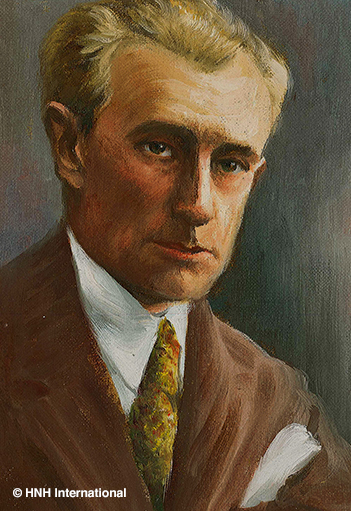
French, of paternal Swiss and maternal Basque descent, Ravel combined skill in orchestration with meticulous technical command of harmonic resources, writing in an attractive musical idiom that was entirely his own in spite of contemporary comparisons with Debussy, a composer his senior by some 20 years.
Stage Works
Operas
Ravel wrote two operas. The first, L’heure espagnole (‘The Spanish Clock’), is described as a comédie musicale; the second, with a libretto by Colette, is the imaginative L’Enfant et les sortilèges (‘The Child and the Enchantments’), in which the naughty child is punished when furniture and animals assume personalities of their own.
Ballets
Ravel wrote his ballet Daphnis et Chloé in response to a commission from the Russian impresario Diaghilev. The work, described as a symphonie choréographique, is based on the Hellenistic pastoral novel of Longus. Ma Mère l’oye (‘Mother Goose’), originally for piano duet, was orchestrated and used for a ballet, as were the Valses nobles et sentimentales and the choreographic poem La Valse. Ravel’s last ballet score was the famous Boléro, a work he himself described as an orchestrated crescendo.
Orchestral Music
In addition to the scores for ballet and arrangements of piano works for the same purpose, Ravel wrote an evocative Rapsodie espagnole (‘Spanish Rhapsody’). Other orchestrations of original piano compositions include a version of the very well-known Pavane pour une infante défunte (‘Pavane for a Dead Infanta’), the Menuet antique, Alborada del gracioso from Miroirs, and pieces from Le Tombeau de Couperin. Ravel wrote two piano concertos: the first, completed in 1930, was for the left hand only, commissioned by the pianist Paul Wittgenstein who had lost his right arm in the war; the second, for two hands, was completed in 1931.
Vocal Music
Songs by Ravel include the remarkable Shéhérazade (settings of a text by Tristan Klingsor for mezzo-soprano and orchestra) and the Don Quichotte à Dulcinée (‘Don Quixote to Dulcinea’) songs, originally written for a film about Don Quixote in which the famous Russian bass Chaliapin was to star. Songs with piano include settings of Jules Renard’s Histoires naturelles, portraying its instinctive sympathy with the birds and the cricket. Ravel’s five unsuccessful attempts to win the Prix de Rome are represented by five cantatas, submitted according to the rules of the competition as he chose to interpret them.
Chamber Music
Ravel’s chamber music includes the evocative nostalgia of Introduction and Allegro for harp, flute, clarinet and string quartet, a violin sonata with a jazz-style blues movement, a piano trio, and a string quartet. Tzigane, written for the Hungarian violinist Jelly d’Arányi, is a remarkable excursion into extravagant gypsy style.
Piano Music
Ravel himself was a good pianist. His music for the piano includes compositions in his own nostalgic archaic style, such as the Pavane and the Menuet antique, as well as the more complex textures of pieces such as Jeux d’eau (‘Fountains’), Miroirs and Gaspard de la nuit, with its sinister connotations. The Sonatina is in Ravel’s neoclassical style and Le Tombeau de Couperin is in the form of a Baroque dance suite.
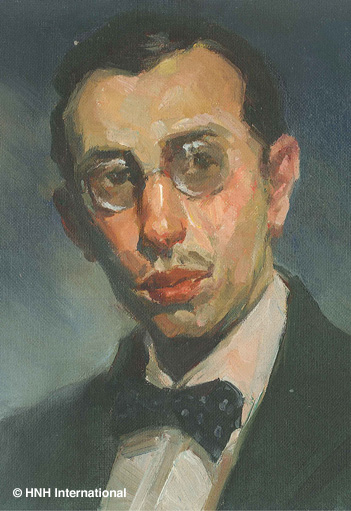
The son of a distinguished Russian singer, Stravinsky spent his earlier years in Russia, either in St Petersburg or, in the summer, at the country estates of his relatives. He studied music briefly with Rimsky-Korsakov but made a name for himself first in Paris with commissions from the impresario Diaghilev, for whom he wrote a series of ballet scores. He spent the years after the Russian Revolution of 1917 in Western Europe and in 1939 moved to the United States of America. There in the post-war years he turned from a style of eclectic neoclassicism to composing in the 12-note technique propounded by Schoenberg. A versatile composer, inventive in changing styles, he may be seen as the musical counterpart of the painter Picasso.
Stage Works
Stravinsky made an immediate impression in Paris with his score for L’Oiseau de feu (‘The Firebird’) for the Ballets Russes of Diaghilev. There followed the very Russian Petrushka, set in a Russian fairground, and then the 1913 succès de scandale of Le Sacre du printemps (‘The Rite of Spring’). After wartime works on a smaller scale, including The Soldier’s Tale, Stravinsky turned again to ballet for Diaghilev in Pulcinella, based on music wrongly attributed to Pergolesi. Later ballets include Apollon musagète, Le Baiser de la fée (‘The Fairy’s Kiss’), Jeu de cartes (‘Card Game’) and Agon. The Latin opera-oratorio Oedipus Rex, with a text translated from Cocteau, was first staged in 1928, while the opera The Rake’s Progress, neoclassical in form and based on the engravings of Hogarth, with a libretto by W.H. Auden and Chester Kallman, was staged in Venice in 1951.
Orchestral Music
Stravinsky’s orchestral music includes symphonies, suites from some of the ballets, and two suites arranged from sets of easy piano pieces. Concertos of various kinds include a 1936 Concerto for piano, wind, timpani and double basses, the Ebony Concerto for jazz band, and a Violin Concerto.
Chamber and Instrumental Music
Stravinsky’s chamber music includes some arrangements of orchestral works, in particular two versions of music from Pulcinella, one for violin and piano and one for cello and piano, both under the title Suite italienne.
Choral and Vocal Music
Stravinsky’s choral music ranges from major works such as the Symphony of Psalms to settings of Latin and Slavonic religious texts, the arranged Four Russian Peasant Songs, and the final Requiem Canticles. His solo vocal works are equally varied, including songs from traditional Russian sources, his sacred cantata Abraham and Isaac with its Hebrew text, the Elegy for J.F.K. with a text by W.H. Auden, and a setting of Edward Lear’s The Owl and the Pussycat.































